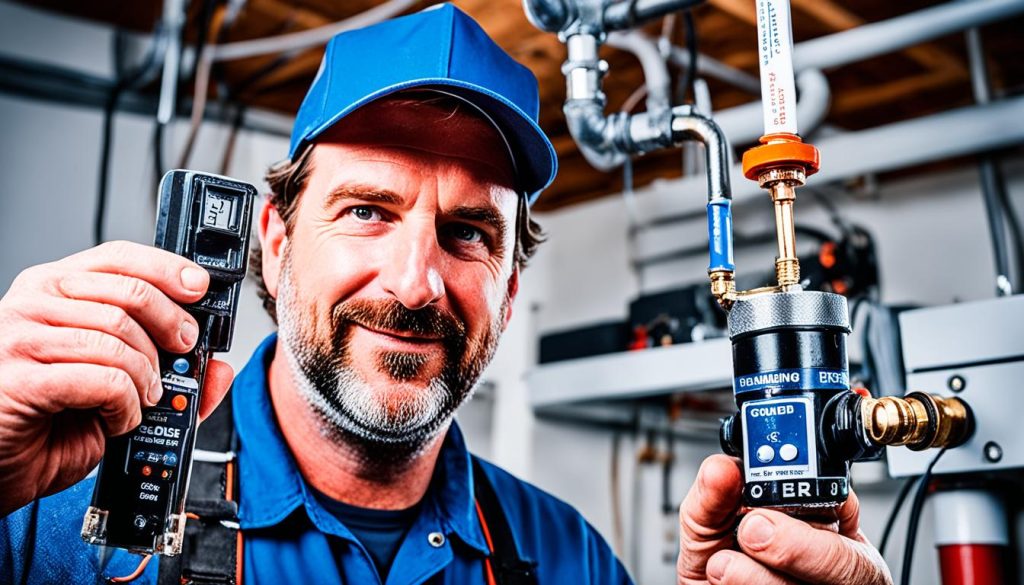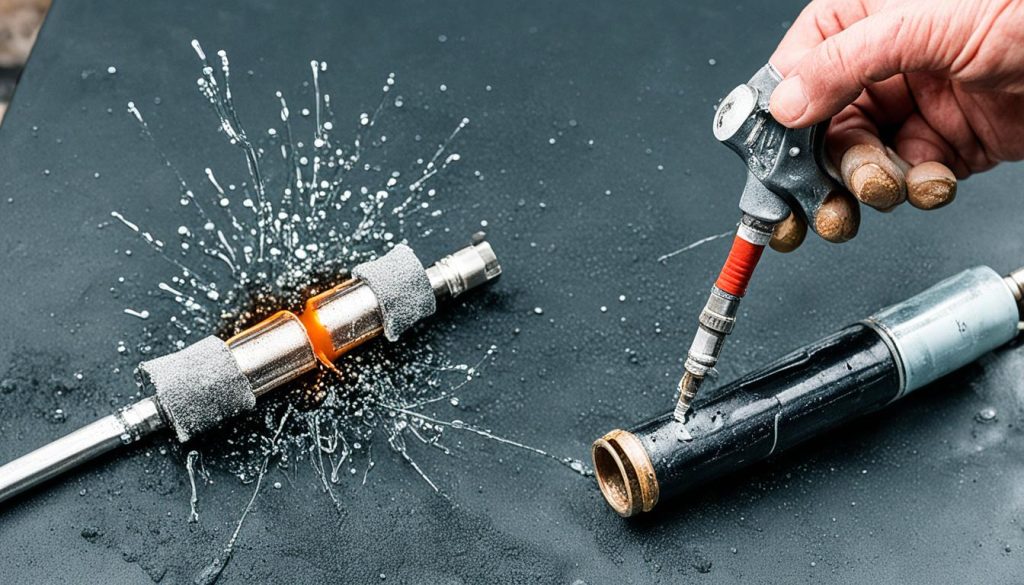Melting Point of Solder for Plumbing Explained
Did you know that the melting point of solder used in plumbing is crucial for creating strong, leak-free joints? It’s a surprising fact that highlights the importance of understanding the ideal solder melting point for plumbers. By choosing the right solder with the appropriate melting temperature, plumbers can ensure reliable connections in plumbing systems.
Key Takeaways:
- The melting point of solder for plumbing typically ranges from 180-190 degrees Celsius.
- Lead-based solder is no longer used in potable water systems due to its harmful effects.
- Lead-free solder, such as copper-tin alloy, is safe to use in water supply lines and has a melting point of 440-520 degrees Fahrenheit.
- Choosing the right solder with the appropriate melting point is essential for creating strong and leak-free joints.
- Follow the proper soldering temperature guidelines to ensure effective bonding of the solder with the metals.
Factors Affecting the Melting Point of Plumbing Solder
Understanding the factors that influence the melting point of plumbing solder is crucial for achieving successful soldering joints. Several key factors can affect the melting point of solder, including the composition of the solder, the type of pipeline it is used in, and the temperature at which it is worked. Let’s explore each of these factors in more detail.
Composition of Plumbing Solder
The composition of plumbing solder plays a significant role in determining its melting point. Traditionally, solder used in plumbing applications contained lead, tin, and copper. However, due to the harmful effects of lead, lead-based solder is now banned in potable water systems. Instead, lead-free solder, such as copper-tin solder, is the preferred option for plumbing. Lead-free solder offers a safer alternative and has a distinct composition that affects its melting point.
Type of Pipeline
The type of pipeline in which solder is used can also impact its melting point. Different plumbing systems, such as drain pipes or drinking water pipes, have specific requirements for soldering joints. The expected temperature and pressure conditions of the pipeline can influence the solder’s melting point. Therefore, it is important to select a solder with the appropriate melting point for the specific plumbing application.
Temperature
The temperature at which solder is worked plays a crucial role in its melting point and workable range. If the temperature is too low, the solder may not melt completely or may take longer to achieve a liquid state. On the other hand, if the temperature is too high, the solder can alloy with the metals being soldered, leading to compromised joint integrity. Therefore, maintaining the correct soldering temperature is essential for achieving strong and reliable soldered connections.
To summarize, when considering the melting point of plumbing solder, factors such as its composition, the type of pipeline, and the working temperature all play a significant role. By understanding these factors and selecting the appropriate solder for the specific plumbing application, plumbers can ensure durable and leak-free soldering joints.
Choosing the Right Solder for Plumbing
When it comes to plumbing, selecting the appropriate solder is crucial for achieving strong and reliable joints. Various factors, including the type of pipe and the soldering temperature, play a significant role in making the right choice. Let’s explore the key considerations for selecting the best solder for your plumbing needs.
Type of Pipe
The type of pipe used in your plumbing system can influence the solder you choose. For potable water systems, it is essential to opt for lead-free solder. Lead-based solder is not only harmful to the environment but also poses health risks. A popular lead-free option for water supply lines is copper-tin solder, which is 100% safe for potable water and possesses the necessary melting point suitable for plumbing applications.
Soldering Temperature
Selecting the proper soldering temperature is critical to ensuring effective bonding between the solder and the metals being joined. To determine the ideal soldering temperature, refer to the manufacturer’s guidelines or consult a professional plumber. Proper temperature control helps prevent overheating or underheating, resulting in strong, leak-free joints.
| Solder Type | Melting Point | Composition | Recommended Use |
|---|---|---|---|
| Copper-Tin Solder | 440-520 degrees Fahrenheit (226-271 degrees Celsius) |
Copper, Tin | Water supply lines, potable water systems |
| Lead-Free Solder | Varies | Varies | General plumbing applications |
Note: The melting points provided are approximate and can vary depending on the specific solder composition.
Choosing the right solder for plumbing is essential for ensuring the durability and integrity of your plumbing system. By considering the type of pipe and following proper soldering temperature guidelines, you can achieve secure, leak-free joints that withstand the test of time. Consult with a professional plumber or refer to manufacturer recommendations to make an informed decision.
Common Mistakes to Avoid During Soldering
When it comes to soldering, there are several common mistakes that can lead to leaky joints. By avoiding these errors and following proper soldering techniques, you can ensure strong and leak-free connections in your plumbing projects. Let’s take a look at some of the most common soldering mistakes and learn how to avoid them:
1. Choosing the Wrong Products
Using the wrong type of solder or flux can result in weak joints that are prone to leaks. It’s crucial to select the appropriate solder and flux for your specific plumbing materials and applications. Refer to the manufacturer’s guidelines or seek advice from a reputable plumbing supplier to ensure you have the correct products.
2. Skipping Preparation Steps
Proper preparation is key to successful soldering. Failing to clean the pipe and fitting thoroughly before soldering can prevent the solder from adhering properly, leading to weak joints. Take the time to remove any dirt, debris, or residue from the surfaces you plan to solder for optimal results.
3. Applying Too Much Flux
While flux is essential for creating clean and reliable solder joints, applying too much can be detrimental. Excessive flux can trap impurities and prevent proper bonding, resulting in weak connections. Apply a thin and even layer of flux to the cleaned surfaces for effective soldering.
4. Overheating the Joint
Applying excessive heat to the joint can cause various issues, including overheating the surrounding materials, burning the flux, and compromising the integrity of the solder joint. It’s crucial to find the right balance and apply heat evenly to achieve a proper solder flow without overheating.
5. Neglecting Post-Soldering Cleanup
After soldering, it’s essential to clean the soldered joint to remove any excess flux or residue. Neglecting this step can result in corrosion over time and compromised joints. Use a clean cloth or brush to remove any leftover flux, and ensure the joint is dry before proceeding.
To summarize, by being mindful of these common soldering mistakes and following proper soldering techniques, you can achieve strong and leak-free joints in your plumbing projects. Take the time to choose the right products, prepare the surfaces adequately, apply the correct amount of flux, regulate the heat, and clean the joints after soldering. These simple tips will help you avoid common soldering errors and ensure the longevity and reliability of your plumbing connections.
| Mistake | Effect | Solution |
|---|---|---|
| Choosing the Wrong Products | Weak joints, potential leaks | Refer to manufacturer’s guidelines or seek advice from a reputable plumbing supplier |
| Skipping Preparation Steps | Improper adhesion, weak joints | Thoroughly clean the pipe and fitting before soldering |
| Applying Too Much Flux | Trapped impurities, weak connections | Apply a thin and even layer of flux |
| Overheating the Joint | Overheated materials, compromised joints | Regulate the heat and apply evenly |
| Neglecting Post-Soldering Cleanup | Corrosion, compromised joints | Clean the joint after soldering to remove excess flux and residue |
The Importance of Premium Alloys and NSF 61 Certification
When it comes to soldering for plumbing applications, choosing the right materials is crucial for achieving reliable and long-lasting results. Premium solder alloys, such as selenium-based or silver-bearing solders, offer distinct advantages over generic lead-free alloys.
One of the main advantages of using premium solder alloys is their superior strength and flow characteristics. These solder alloys provide better bonding and create more durable joints, resulting in leak-free plumbing installations that stand the test of time.
In addition to the benefits of premium solder alloys, it is highly recommended to select products that have obtained NSF 61 certification. This certification ensures that the solder is safe for use in potable water systems and does not introduce harmful contaminants at unsafe levels. By choosing solder with NSF 61 certification, you can have peace of mind knowing that your plumbing installations meet rigorous quality and safety standards.
Investing in high-quality solder and certified products is essential for any plumbing project. By selecting premium solder alloys and NSF 61 certified options, you can ensure the integrity of your plumbing joints, minimize the risk of leaks, and maintain the highest standards of water quality for years to come.
- Investing Wisely: How Windows & Doors in Boost Property Value and Financial Health - April 24, 2025
- The Financial Impact of Personal Injuries: Why Legal Help Matters for Business Owners - April 16, 2025
- The Hidden Financial Costs of Domestic Assault: What Business Owners Need to Know - April 16, 2025













